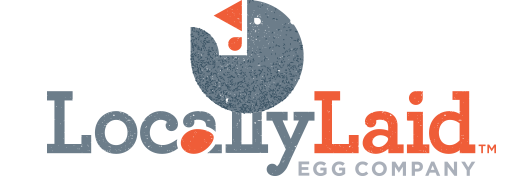Frequently Asked Questions

A. The name Locally Laid reflects our commitment to producing eggs so fresh they’re sassy, with the lowest possible carbon footprint for discerning locavores. Also life is short; take every opportunity to smile.
A. We have just about 2,500 laying hens, all of whom are outside daily and sheltered in hoop coops. They’re a mixture of Bovan Browns, Gold Stars and the odd California White. And the 650 peeping chicks that arrived last spring are now laying.
A. Yes, they are all named LoLa – the “Lo” is short for Local and the “La” from Laid. We also like The Kink’s song.
A: No. they’re better than that. The term free-range is nutty confusing. In the United States, it means only that an animal is allowed some access to the outside. There are no regulations that specify the size of the outside space, if it is grass, dirt or cement, or the duration of the chicken’s respite from the barn. It does not mean that these hens eat any sort of fresh field greens.
Our ladies are Pasture Raised. Pasture-raised birds live on pasture with full access to shelter. Locally Laid chickens graze on fresh grass, are given feed, and have lots of outside space to exercise. They’re salad-eating, poultry athletes – and a healthier bird flat out lays a healthier egg.
A. Our farm is in Wrenshall in the beautiful Northland region of Minnesota. We also partner with family farms in Kalona, Iowa and Northern Indiana that produce Locally Laid eggs to our pasture-raised standards.
A. Soon! We moved to a new farm in November and hope to offer tours in the future. Drop us an email and we’ll try to work something out in the future – lucie [at] locallylaid com.
A. No, we’re not set up for on-site sales. Total bummer.
A. In addition to what the chickens find on pasture, we feed our hens a ration of local, non-GMO corn, soybean meal, alfalfa meal and calcium for shell building. Given that corn comprises over half of our hens’ ration, we believe that non-GMO corn is the way to go. Even though it’s more expensive, we believe on a number of levels it’s a better product. It’s also just the right thing to do.
A. We plant a tree with every delivery and every sassy, American-made tee we sell.Though we’ve only been selling eggs for 14 months, we’ve planted nearly 2,100 trees as of spring. (We’re kinda proud of that.)
No, and it bums us out. Here’s why. Most of the organic feed for animals in this country comes from China. Yeah, China. You can listen to an NPR story about it here.
We are constantly seeking to add organic producers to our suppliers and are proud to have secured a non-GMO corn grower in our region. (Not easy!) However, we want continue heading in the right direction in regards to organic standards.
A. No. because an egg comes from an organic hen doesn’t mean she goes outside, exercises on the fields, functions as a flock or eat seeds & grass like our girls do. Unless a carton states the chickens are on pasture, rest assured they’re not.
A. This winter the hens had a barn for the first time. Given our record 70-something days below zero and polar vortex temps down to -35, we wouldn’t have made it through this harsh season without the new shelter.
To help them cope with being cooped up, we set up kiddie pools with sand so they could take dust baths and also sprouted wheat grass for them to give them a taste of the green.
We heat the barn with a diesel generator that’s being converted to french fry oil. Stay tuned for updates.

